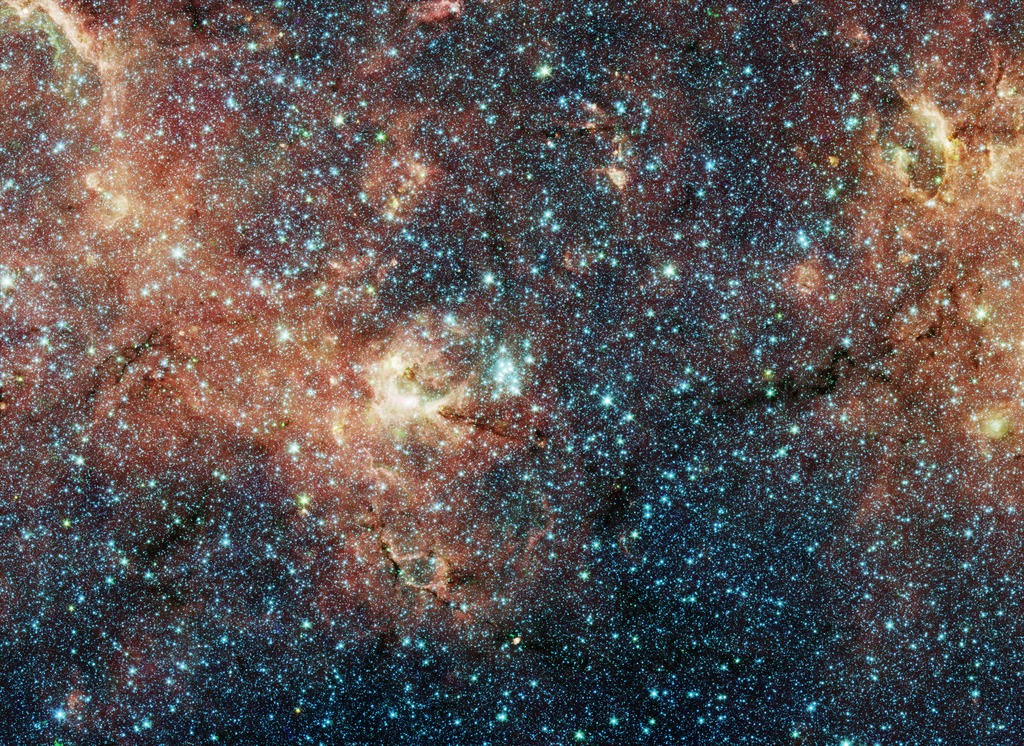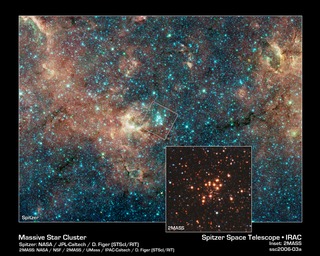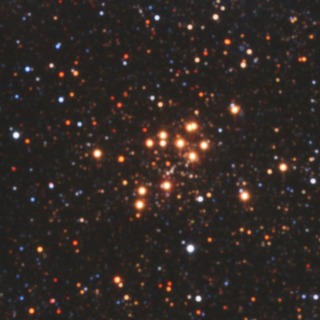
Credit: NASA/JPL-Caltech/D. Figer (STScI)
Observation • January 9th, 2006 • ssc2006-03a1
ssc2006-03a1
The sky is a jewelry box full of sparkling stars in these infrared images. The crown jewels are 14 massive stars on the verge of exploding as supernovae.
These hefty stars reside in one of the most massive star clusters in the Milky Way Galaxy. The bluish cluster is inside the white box in the large image, which shows the star-studded region around it. A close-up of the cluster can be seen in the inset photo.
These large stars are a tip-off to the mass of the young cluster. Astronomers estimate that the cluster is at least 20,000 times as massive as the Sun. Each red supergiant is about 20 times the Sun's mass.
The larger color-composite image was taken by the Spitzer Space Telescope for the Galactic Legacy Infrared Mid-Plane Survey Extraordinaire (GLIMPSE) Legacy project. The survey penetrates obscuring dust along the thick disk of our galaxy to reveal never-before-seen stars and star clusters.The false colors in the image correspond to infrared-light emission. The stars in the large color-composite image all appear blue because they emit most of their infrared light at shorter wavelengths.
The cluster lies 18,900 light-years away in the direction of the constellation Scutum. It is the first in a survey of 130 potentially massive star clusters in the Milky Way that astronomers will study over the next five years using a variety of telescopes, including the Spitzer and Hubble space telescopes.
The Spitzer image was taken April 4, 2004.
The science team that studied the star cluster consists of Don Figer, Space Telescope Science Institute/Rochester Institute of Techology; John MacKenty, Massimo Robberto, and Kester Smith, Space Telescope Science Institute; Francisco Najarro, Instituto de Estructura de la Materia in Madrid, Spain: Rolf Kudritzki, University of Hawaii in Honolulu; and Artemio Herrero, Universidad de La Laguna in Tenerife, Spain.
The science team that studied the star cluster consists of Don Figer, Space Telescope Science Institute/Rochester Institute of Techology; John MacKenty, Massimo Robberto, and Kester Smith, Space Telescope Science Institute; Francisco Najarro, Instituto de Estructura de la Materia in Madrid, Spain: Rolf Kudritzki, University of Hawaii in Honolulu; and Artemio Herrero, Universidad de La Laguna in Tenerife, Spain.
About the Object
- Name
- Type
- Nebula > Type > Star Formation
- Star > Grouping > Cluster
- Star > Evolutionary Stage > Red Supergiant
- Distance
- 18,900 Light Years
Color Mapping
| Band | Wavelength | Telescope |
| Infrared | 3.6 µm | Spitzer IRAC |
| Infrared | 4.5 µm | Spitzer IRAC |
| Infrared | 8.0 µm | Spitzer IRAC |
Astrometrics
- Position ()
- RA =18h 37m 60.0s
- Dec = -5° 12' 0.0"
- Field of View
- 0.0 x 0.0 arcminutes
- Orientation
- North is up






